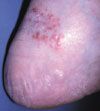- Clinical Technology
- Adult Immunization
- Hepatology
- Pediatric Immunization
- Screening
- Psychiatry
- Allergy
- Women's Health
- Cardiology
- Pediatrics
- Dermatology
- Endocrinology
- Pain Management
- Gastroenterology
- Infectious Disease
- Obesity Medicine
- Rheumatology
- Nephrology
- Neurology
- Pulmonology
Actinic Cheilitis in a 67-Year-Old Man and Staphylococcal Infection in a Woman With Eczema
This crusted eroded area on the lower lip of a 67-year-old man has been presentfor several months.Which of the following statements are true?A. This condition preferentially affects the lower lip.B. It is more common in women.C. It is more common in immunocompromised patients.D. It is more likely to metastasize than similar lesions on nonmucosal surfaces.E. 5-Fluorouracil is contraindicated in this location.

Case 1:
This crusted eroded area on the lower lip of a 67-year-old man has been presentfor several months.Which of the following statements are true?
A. This condition preferentially affects the lower lip.
B. It is more common in women.
C. It is more common in immunocompromised patients.
D. It is more likely to metastasize than similar lesions on nonmucosal surfaces.
E. 5-Fluorouracil is contraindicated in this location.

Case 1: This patient has actinic cheilitis,an actinic keratosis that occurs onthe lower lip. A, C, and D are true. Actiniccheilitis is more common in menand in immunocompromised patients.It has a greater propensity to metastasizethan keratoses in other locationsand is associated with significant mortalitywhen metastasis occurs. Acceptedtreatments include 5-fluorouracil,cryosurgery, and surgical excision.

Case 2:
A 44-year-old woman with long-standing eczema presents with an exacerbationthat consists of tender crusted lesions on the face.
What is the most likely cause of the exacerbation?
A. Herpes simplex.
B. Candidiasis.
C. Streptococcal infection.
D. Staphylococcal infection.
E. Factitial disease.Your approach will likely include:
F. Bacterial culture.
G. Fungal culture.
H. Herpes culture.
I. Biopsy.
J. Psychiatric consultation.

Case 2: A bacterial culture grew Staphylococcus aureus,D; staphylococcalinfection is more common in atopic persons than in persons who do not haveatopy-as is candidiasis. In persons with atopy, herpes simplex presents onrare occasions with extensive involvement that occurs within the usual areaof distribution of the patient's eczema. It is not unreasonable to pan-culture(ie, to order bacterial, F, fungal, G, and herpes, H, cultures at the same time)if the diagnosis is uncertain.
This patient's eruption rapidly responded to a course of cephalexin. If theinfection recurs, treatment for nasal carriage of S aureus (eg, mupirocin ointmenttwice a day for a week) is appropriate.

Case 3:
A 52-year-old woman who has recently returned from aweek at a dude ranch complains of a pruritic rash on theback of 1 heel. Neither clotrimazole nor 1% hydrocortisonebrought relief. She recently purchased a new pair ofshoes.
To what do you attribute the patient's rash?
A. Dyshidrosis.
B. Contact dermatitis.
C. Candidiasis.
D. Dermatophyte infection (tinea pedis).
E. Insect bite reaction.
Bonus question: What are the flesh-colored papules onthe heel below the rash?

Case 3: A potassium hydroxide preparation of a lesionwas positive for dermatophyte infection, D. Application ofa topical allylamine antifungal cream was curative.Dyshidrosis is usually symmetric and erupts alongthe edges of the sole. Contact dermatitis to shoes typicallymanifests on the dorsum of the foot; in addition, becausethis patient's rash did not affect both heels, it was unlikelyto be related to her new shoes. Candidiasis is not likelyto be found on the feet. Insect bite reactions usually occuron the exposed part of the ankle.
Answer to bonus question: These are piezogenic papules,which result from herniation of fat through the dermis.The papules, which generally occur bilaterally,become apparent on weight bearing and are most oftenasymptomatic.

Case 4:
The solitary yellow-orange papule above this 2-year-old's eyelid has beenpresent for a month. It does not appear to itch or cause any discomfort. Canyou identify the entity underlying this cutaneous lesion?

Case 4: This lesion is juvenile xanthogranuloma, a benign histiocytic infiltrationof the skin that produces 1 or more asymptomatic yellowish to orangepapules. The clinical impression was confirmed by biopsy, which showed typicalnodular histiocytic proliferation and foam cells.
Juvenile xanthogranuloma generally appears in the first year of life-mostfrequently on the head and neck-and may last for 3 to 6 years before undergoingspontaneous involution. Ophthalmologic examination is recommended,because the lesions may affect the eye-the uvea in particular-during infancy,resulting in hemorrhage and glaucoma. In this case, the pediatric ophthalmologistfound no abnormalities in the child's eyes. The biopsy was curative,and no further treatment was indicated.
